The law condemns the man or woman
The Devon Evening Express, 27th December 1883
Who steals a goose from off a common;
But lets the greater villain loose
Who steals the common from the goose.
Since 2019 I had been trying to raise awareness of a historical boundary stone that once stood on the east slope of Cosdon Hill but for reasons unknown was discovered recumbent far from its original position, in a field in the village of South Zeal. This sorry state of affairs prompted me to approach South Tawton Parish Council to ask for this small piece of little known local history to be instated for all to enjoy properly.
It has been a long wait, exacerbated by the COVID lockdown, and lengthened further by problems sourcing a contractor but the boundstone is now upright two years on (August 2021). There is more on that, and the other stones later, but first I would like to share the story of what this boundary was and how it came into being.
‘THE BATTLE OF BALACLAVA’
William Crossing first drew my attention to the subject, when describing a boundary stone at Rabbits’ Holt;
Here is a stone about 6 feet in height, one of a line erected in 1885, to mark the boundary of certain mineral rights, and also that between what was anciently known as the manor of Zeal Toeny and the land over which the Duchy claims jurisdiction. There have been frequent disputes between the commoners of South Tawton parish and the Duchy. It is claimed by the former that they have a right to enclose, and, as will be seen, they have fenced in a good part of the side of the hill opposite Ramsleigh and West Week… On one face of the stone in question are the letters S Z, with the figure 2 beneath them, and on the other the letters D C, and a similar figure. These stand for South Zeal and Duchy of Cornwall respectively, the figure being merely the number of the stone. Another of the stones may be seen near the corner of Skaigh, to the N.W. ; and a third hard by the enclosures to the S.E
William Crossing: Guide to Dartmoor (1909)
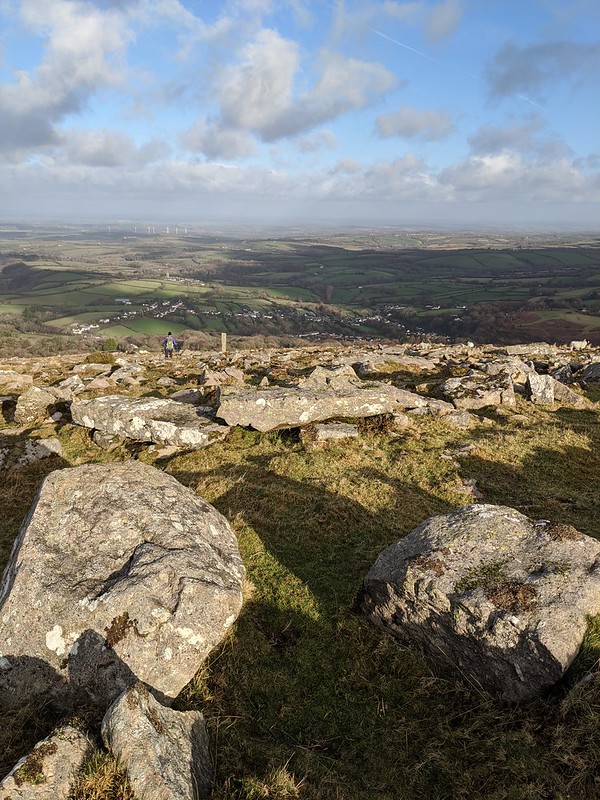
Crossing does explain the following event, but it is local ‘Chronicler of Dartmoor’ Douglas Francis Edward St. Leger Gordon who, in his book ‘Dartmoor in All its Moods’, better described an altercation between the residents of South Zeal and the Duchy:
… some years ago there occurred an incident which has become famous in Dartmoor History. Certain inhabitants of South Zeal, having taken it into their heads to enclose various sections of common land along the Blackaton Valley, proceeded to do so. A considerable amount of land had been taken in, when the Duchy of Cornwall, deciding to act in the matter, dispatched men to wreck the enclosures and demolish the walls that had been built. Before the work of demolition had made much headway, however, the would-be squatters, doubtless reinforced by contingents of friends and relatives, arrived upon the scene in strength, armed with every sort of crude weapon the village could produce, and as the result of a violent altercation, the representatives of law and authority were obliged to retire from the field, the scene of the encounter bearing the name of Balaclava to this day.
Douglas Francis Edward St. Leger Gordon: Dartmoor in All its Moods p.27-28 (1931)
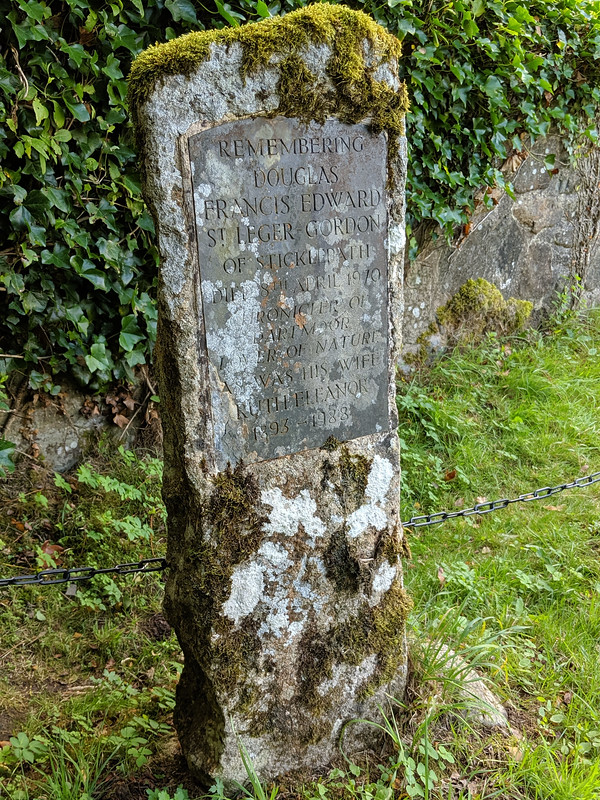
Suffice to say, an incident of civil disorder such as this made the newspapers and as a result we can date the ‘battle’ to Thursday, 13th December 1883. The articles make for fascinating reading and with them we can piece together a more detailed account of events. Let us start with the altercation;
EXCITING SCENE AT SOUTH ZEAL
The Royal Cornwall Gazette: 21st December 1883
For several years past a number of the residents at South Zeal, a village situate on the northern extremity of Dartmoor, and about three miles from Okehampton, have enclosed and cultivated portions of Dartmoor which the Duchy of Cornwall authorities claim as being their property. The parishioners who have made the enclosures have, it is understood, been given the opportunity of paying a nominal sum as an acknowledgement that the land was not their property in perpetuity, but this they declined to do. Yesterday (Thursday) week, Mr. Barrington, the Duchy steward, took with him to South Zeal fifteen men, being navvies and quarrymen, one sergeant and six constables for the purpose of asserting the rights of the Duchy, by pulling down the hedges and fences. The party were conveyed from Princetown and neighbourhood to Okehampton by rail, and from thence to South Zeal by hired conveyance from the White Hart Hotel. The men were provided with shovels, digging picks, and similar implements; but the nature of the intended operations does not appear to have been known to them until they arrived on the scene of their labours. In accordance with instructions, although with a certain amount of reluctance, the men commenced by levelling the hedges; but before they had proceeded very far with their depredations, their movements were observed by the villagers, and a general hue and cry was given. Armed with such weapons as were to hand, such as hooks, scythes, and sticks, the people proceeded to attack the invaders of their territory, which is locally known by the name of the “Little Ireland.” The visitors, however, considering “discretion the better part of valour” ceased their operations, and retired before the superior numbers and weapons of their opponents. It is stated that the steward intimated his determination of making another attack when he will be provided with a stronger force, including, it is said, military assistance. The excitement at South Zeal runs high. The enclosures have in some case been very productive and valuable, and no doubt a few persons were cherishing the hope that they would be able to claim ownership after a certain number of years’ possession.”
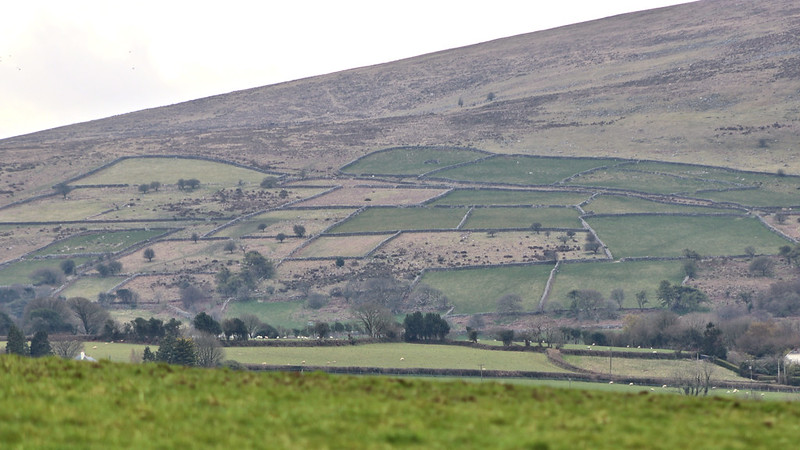
Thirteen days later, in an open letter, the Duchy proceeded to give their account of the incident;
THE SCENE AT SOUTH ZEAL
Sir, – In regard to the scene which lately occurred in the neighbourhood of South Zeal, I think it proper to make known that, after having made previous communications, I, by direction of the Prince of Wales’s Council, addressed a circular letter in May last to the various parties who had effected unauthorised enclosures on the common lands in the parishes of Throwleigh and South Tawton, on the north of Dartmoor, the soil of which lands, subject to the rights of the commoners, is parcel of the possessions of the Duchy of Cornwall, pointing out the necessity of requiring the Duchy title to be recognised, and offering to each, free of charge, a lease for 31 years of his encroachment, at a rent varying from 1s. to 7s. 6d. per annum, according to the extent thereof, which in some cases exceeds seven acres, and stating that in default of an acceptance of such offer I had instructions to direct the pulling down of the fences that had been erected.
The offers so made having met with no response, directions were eventually given to assert the rights of the Duchy pulling down the fences of certain particular enclosures on Throwleigh Common, and it was while these directions were being given effect to that the inhabitants of the adjoining parish of South Tawton assembled and made their attack on the workmen employed.
– I am, sir, your obedient servant, GEO WILMHURST.
Duchy of Cornwall Office, Buckingham Gate, S.W., 22nd December, 1883.
Open letter from Geo. Wilmhurst of the Duchy Office, Western Daily Mercury, 26th December 1883
It would appear, from the Duchy version of events, that the squatters were not even part of the parish where the incident occurred, something that Douglas Gordon was to later remark upon;
A somewhat ironical point that did not, I think, arise during the transaction, lay in the fact that at least a part of the contested land belonged to Throwleigh Parish, the position of South Tawton commoners in the matter being therefore delicate at best.
Douglas Gordon: Dartmoor in All its Moods p.28 (1931)
Despite this, why did they feel they could ignore the Duchy offer or had any legal claim to the land? Their reasoning is explained in another article, as is the predicament they were faced with;
The total area of the enclosures, which skirt the three beforementioned villages, amount to between 200 and 300 acres. For the most part they consist of small allotments, many of which have existed for twenty years, and some for even thirty, while others again have only been taken possession of and brought into a state of cultivation during the present year. The majority of the enclosures are held by farm labourers and men of similar station in life, and have been brought in many instances to a highly productive state. Indeed the produce of these plots has been the means of keeping a goodly number people at South Tawton and Throwleigh off “the parish” in hard times… Those, however, who had held possession of plots for 20 years and upwards cherished the hope that they could claim ownership, and they therefore regarded the advent of Mr. Barrington and his party as a grievous and unwarranted intrusion and resented it accordingly. The Duchy, unlike private individuals, does not lose its manorial rights until after the expiration of 60 years, and none of the “owners” of the enclosures being able to date so far back, all of them will probably find that they have by no means acquired a legal claim to hold the land rent free. It is possible, however, that the commoners have lost their rights over that portion of the common which has been enclosed for twenty years and upwards. It is expected that within the course of a few days a meeting will be held at South Zeal, at which it will be proposed that the Duchy stipulations will be accepted.
The Western Morning News, 21st December 1883
Whilst it was true there was sympathy for the view of the ‘squatters’, there was also support for the Duchy;
A very unwise attempt, as I think, has been made to excite sympathy with the encroachments at South Zeal on the Duchy wastes. I recognise to the full what has been done by the enclosers in the way of reclamation, and, if you like the title even, though they did trespass, to be recouped for their labour. But what I say is this. If it is wrong for the lord of a manor to filch a common from the commoners, mindful of the old rhyme: –
The law condemns the man or woman
Who steals a goose from off a common;
But lets the greater villain loose
Who steals the common from the goose –
if it is wrong, I say, for a lord of a manor to steal a whole common, it is equally wrong for a villager to steal a little bit of one and for the life of me I can’t see that the Duchy authorities have acted harshly in their demand of 1s. acre rent on a thirty years’ lease. I want to see public rights protected against everybody, and fair play all round; and here the letter of the land would certainly admit of very much harsher dealing. No one pretends to say that those villagers had any rights but what they themselves manufactured. Where is the real grievance in compelling what after all, so far as the present holder is concerned, is a nominal recognition? And really it is too much to plead as a lady does, quite ad misericodiam in behalf of some of the enclosers, who not only helped themselves to what land they wanted, but sold it to other people!
The Devon Evening Express, 27th December 1883
THE DEED OF CONVEYANCE
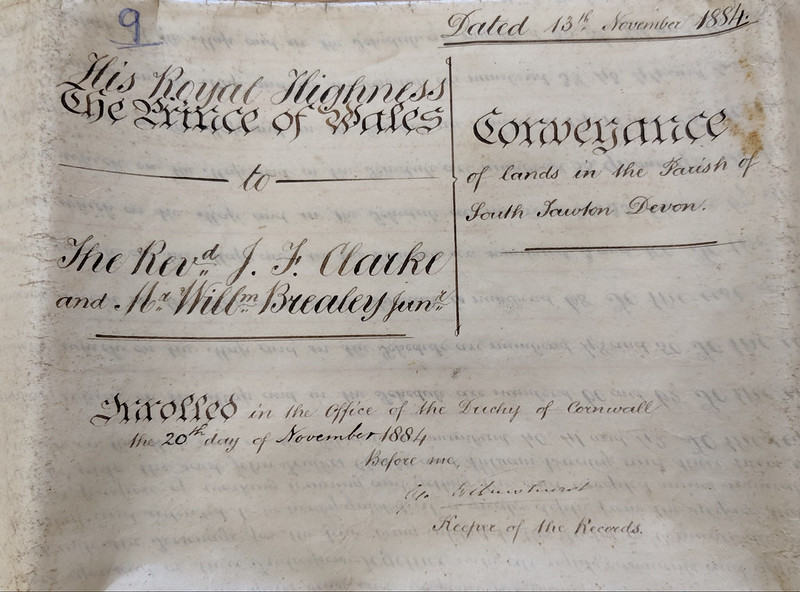
Faced with the very real prospect of the loss of the land, the residents reluctantly accepted a deal and by the end of 1884, an agreement was reached. A sum of fifty-seven pounds, nine shillings (modern day equivalent of about £4,000) was paid to the Duchy of Cornwall and the ‘Conveyance of lands in the Parish of South Tawton’ was completed on 20th November 1884.
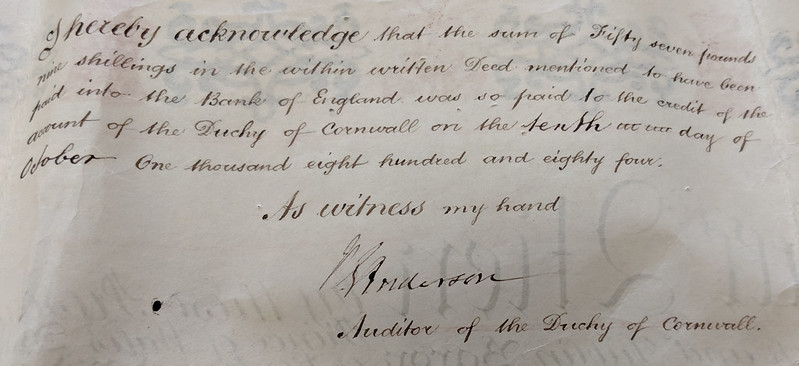
The Reverend J.F. Clarke felt obliged to send this open letter to local newspapers the following day;
THE DUCHY AND THE COMMONERS
To the Editor of “The Daily Western Times.”
Sir, – At the close of last year our parish had the painful experience of seeing the throwing down of enclosure walls on Dartmoor, under legal process, and the resistance to such process on the part of some inhabitants of South Zeal It was especially painful to those who knew of the self denying toil which had been expended in bringing barren moorland into a condition equal at least to that of the average land in the rest of our parish. It was felt to be no less serious that equitable right on the part of the people should be apparently opposed to the legal rights of those in Authority. Some letters appeared in the daily press strongly expressing sympathy with the peasantry. One letter was written to the Duchy of Cornwall Office with a fair account of the circumstances. The answer to this letter stated, that now for the first time was any written reply made on the part of the enclosers of land to frequent communications from the Duchy, and that the throwing down was confined to the Throwleigh Common in order that the least possible injury might be inflicted in maintaining the right of the Duchy of Cornwall to the soil. When the matter came to be submitted a most gracious offer was made, allowing the enclosers of land to purchase the fee-simple of their fields at the rate of ten shilling an acre. The offer was thankfully accepted. Every penny was paid by Michaelmas last, together with two guineas for the deed of conveyance to two trustees.
Yesterday I had the pleasure showing that deed to all who were interested it and I had the equal pleasure of hearing their heart-felt expressions of gratitude to his Royal Highness the Prince of Wales.
In conclusion I feel justified in saying that I have observed the most beneficial effects on my parishioners in South Zeal from the happy labour which has won men from self-indulgent pleasures to the peaceful task of turning stone-cumbered Moors into land useful to the whole community.
The villagers are, as a body, law abiding, self respectful and courteous. Long may they enjoy their hard won fields. Long may our gracious Prince live to enjoy the homage of grateful hearts
I am, Sir, yours faithfully, J.F. Clarke, South Tawton Vicarage, 27th November, 1884.
Letter to the Editor from Rev. J.F. Clarke, Western Times, 1st December 1884
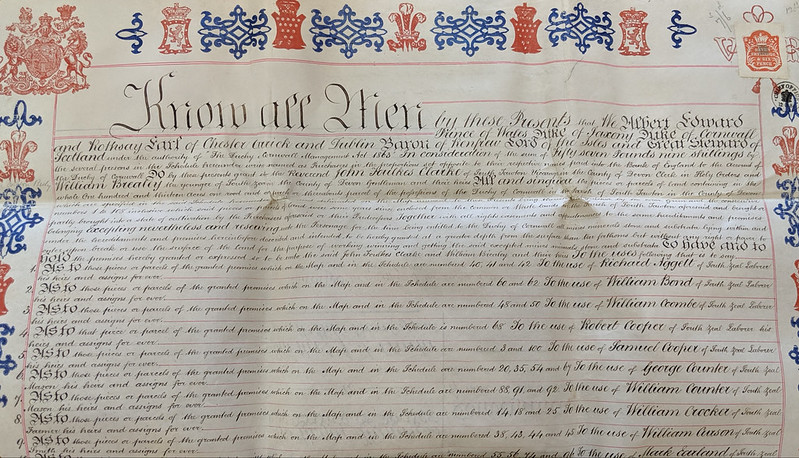
THE BOUNDARY STONES
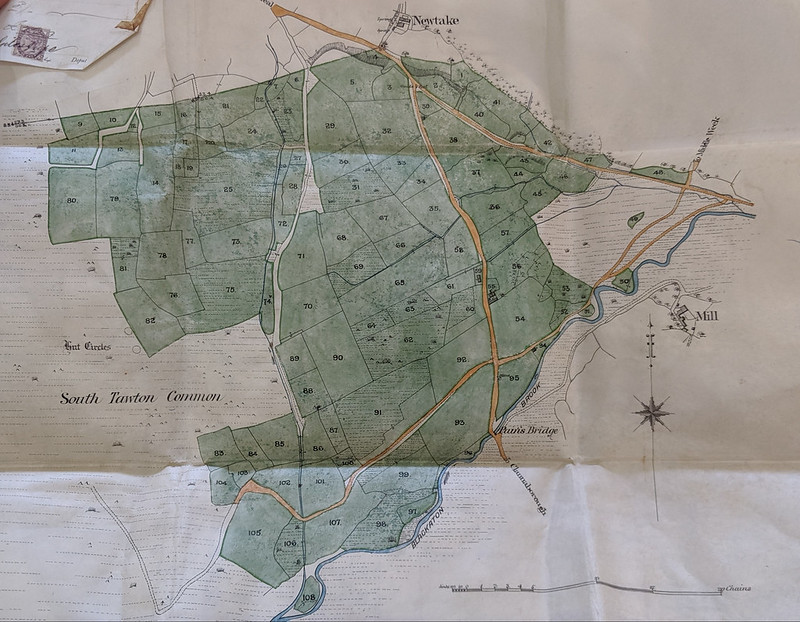
The Conveyance documents, which can be seen by appointment at the Devon Archive Centre in Exeter, include a map which shows the plots of land and, crucially, the site of three boundary stones marked ‘SZ 3, SZ 4 and BS’. The preceding two; ‘SZ 1 and SZ 2’ are not shown as they are not in the area displayed or relevant to the land associated with the Conveyance but that is not a problem as fortunately they still stand in their original positions.
You will recall that Crossing states the stones were erected in 1885, which suggests installation occurred after the deed was signed in November 1884. There is, however, an Ordnance Survey 25 inch map surveyed in 1884 that shows a ‘Stone’ in a spot that corresponds with the Conveyance maps position for ‘SZ 3’.
Which brings us to the boundary stones themselves;
THE FIRST STONE
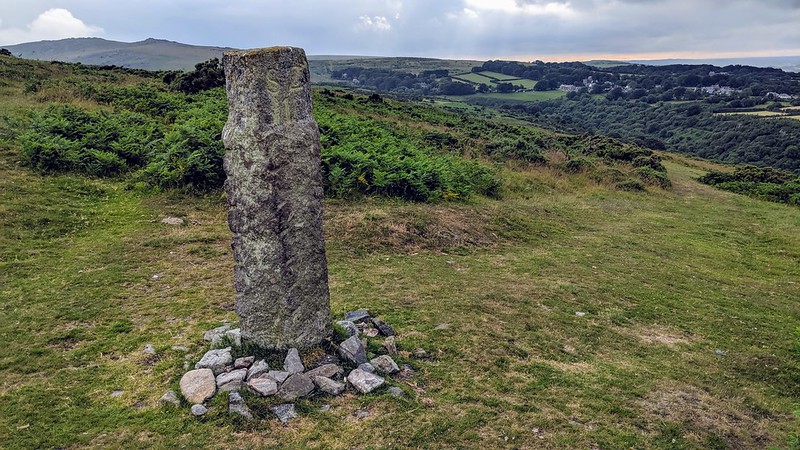
A rambler ascending from Belstone, with the intention of reaching the summit of Cosdon, will likely pass this fine granite post close to the boundary wall of Skaigh known as Ska Corner (Grid SX 63307 93312). Closer inspection of this impressive stone reveals the inscriptions ‘SZ 1’ and ‘DC 1’.

THE SECOND STONE
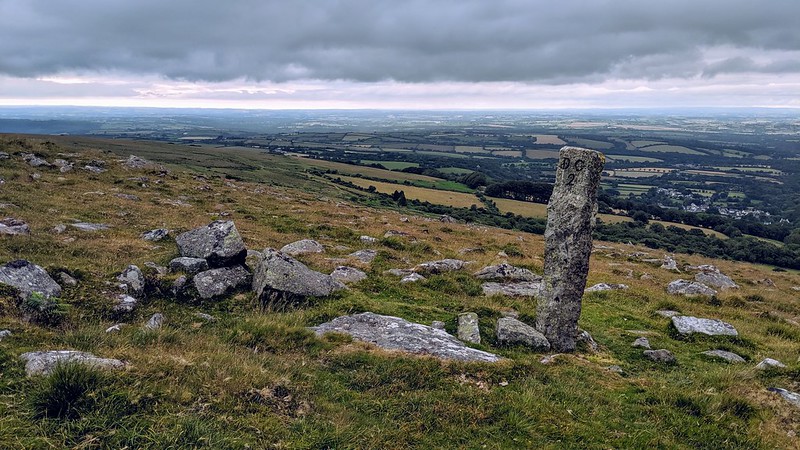
As before mentioned, at Rabbits’ Holt, or as marked on Ordnance Survey maps, ‘Foxes Holt’, you’ll find another granite post at SX 64029 92543. This is the most well-known of the bound stones, labelled as ‘Stone Post’ by Ordnance Survey and the only one that is still marked on modern maps.
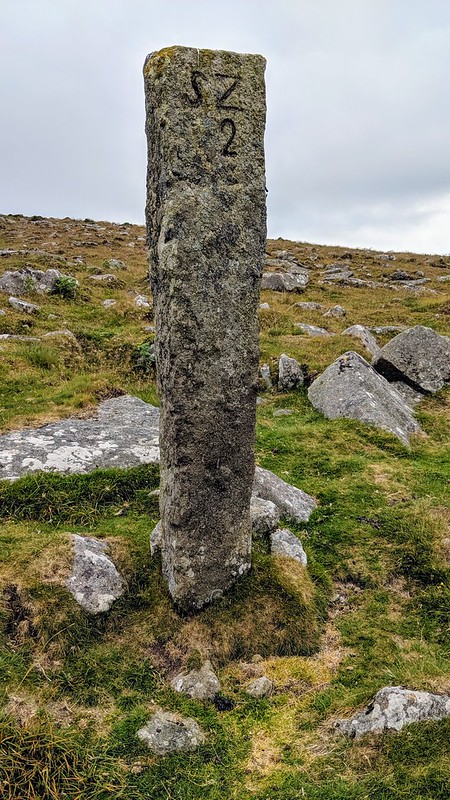
THE THIRD STONE
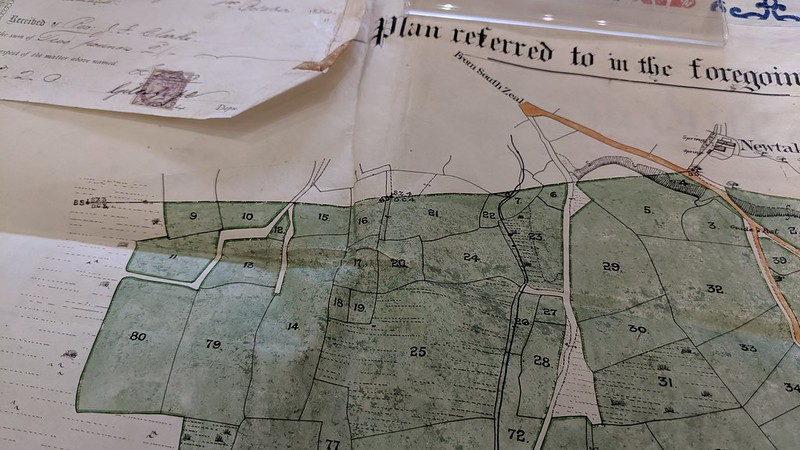
Crossing gave us a rough indication as to the location of the third stone being “hard by the enclosures to the S.E.“. Using three pieces of evidence (Crossing, the old OS map and Conveyance Map) we can confidently place it at OS Grid Reference SX 6497 9206.
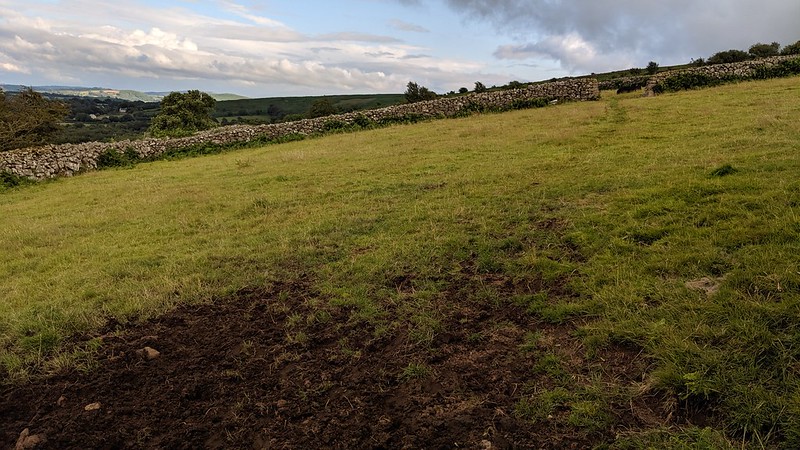
Sadly, the enclosures have encroached further up the hill in the preceding years and the location is now on private land. With no obvious candidate visible from the boundary walls, I fear ‘SZ 3/DC 3’ was likely plundered for building materials.
THE FOURTH STONE
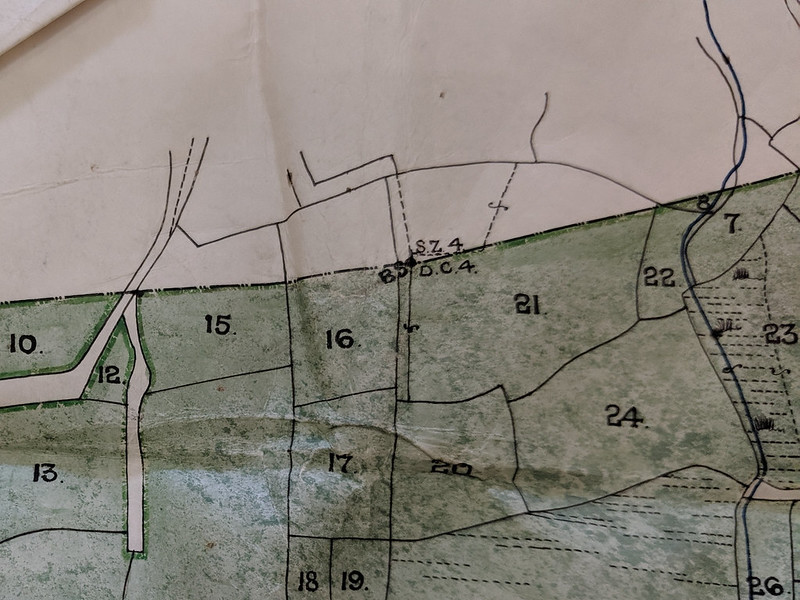
The Conveyance map shows the position of ‘SZ 4/DC 4’ lower down the hill, forming part of a straight line from the third stone to a fifth by the road. As with the third, a similar fate met the fourth stone. Matching field boundaries with an OS map we can ascertain it once stood at SX 65308 92130.
Crossing only mentioned the first three stones, he may have been unaware of the fourth or encroachment may have already occurred when he visited and it may have been moved already. Fortunately, it was not broken up or incorporated in a wall, instead it was moved into South Zeal.
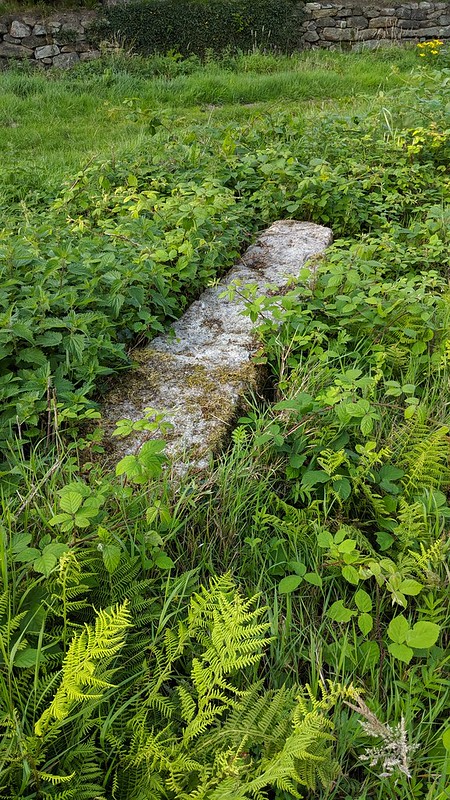
This antiquity lay as an edging stone behind Zeal Mills in the village of South Zeal at SX 65084 93471 for some thirty years, having been moved from Nine Stones with other granite to line the pavement. Its position was also listed in the Devon and Dartmoor Historic Environment Records albeit incorrectly classified as a Parish Boundary Stone.
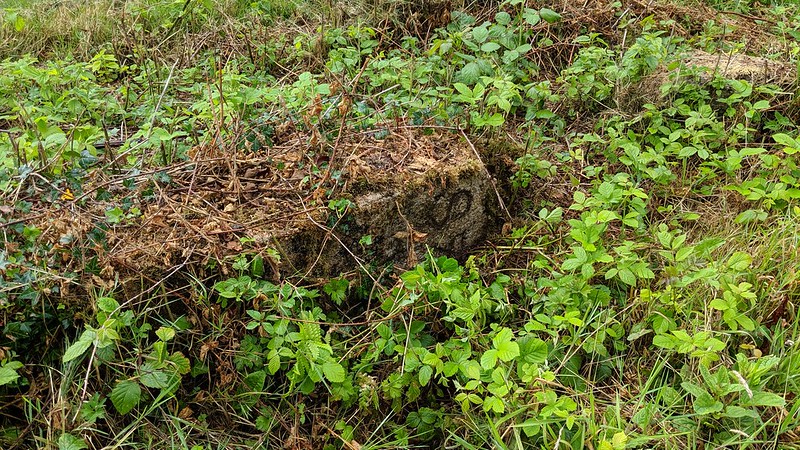
On the side nearest the footpath, the inscription “SZ 4” could be seen and on the opposite, “DC 4” but vegetation often concealed both. Its size was recorded as 200cm x 30cm x 30 cm.
But now, with the aid of the South Tawton Parish Council, the landowner granted permission to relocate the bound stone.
With its original position on Cosdon not an option, it was agreed by all concerned that it should be placed in a more prominent position within the village recreation ground where the stone will be enjoyed.
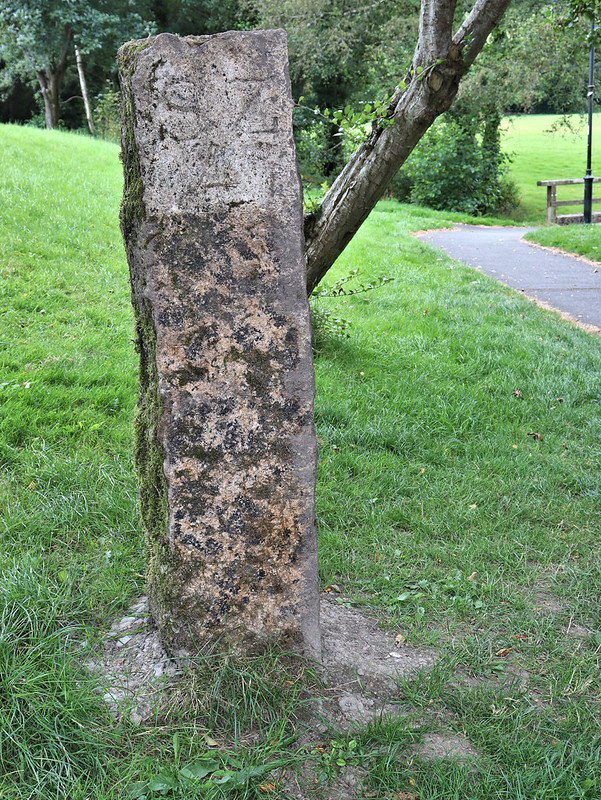
In August 2021, the stone was instated and in March 2022, an information board, written by myself, was erected to tell the story of the altercations.
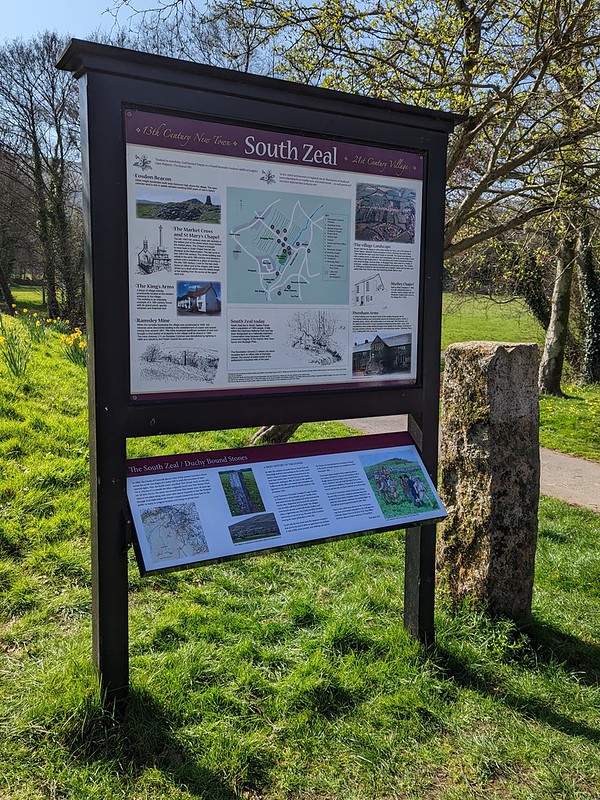
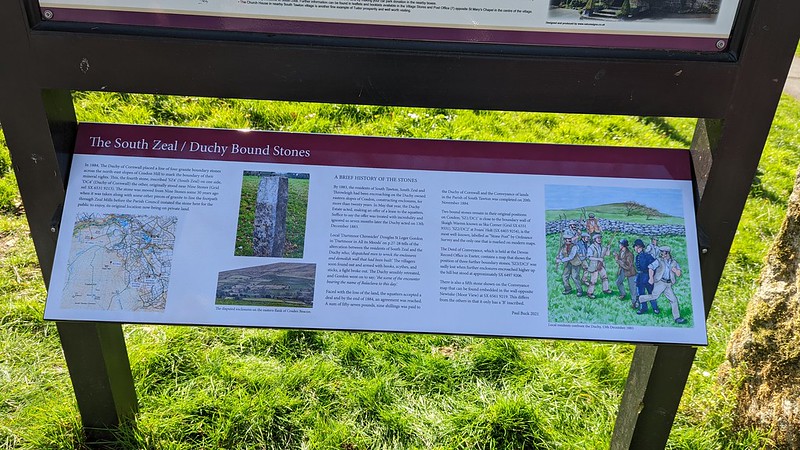
THE FIFTH STONE
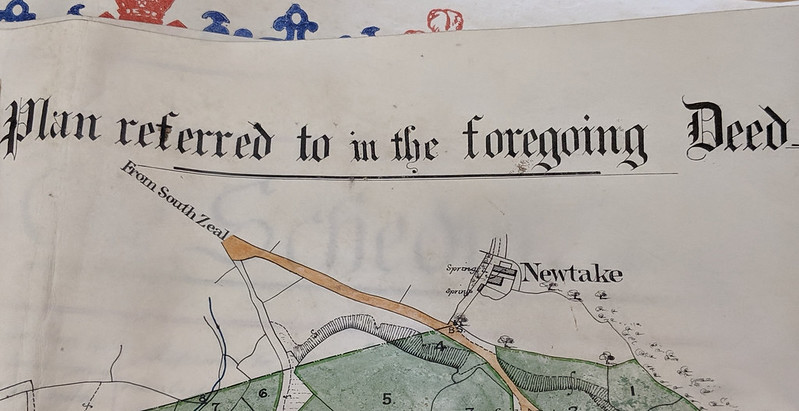
There is a final stone shown on the Conveyance map beside the road close to the entrance to a building called ‘Newtake’. The property is now called ‘Moor View’.
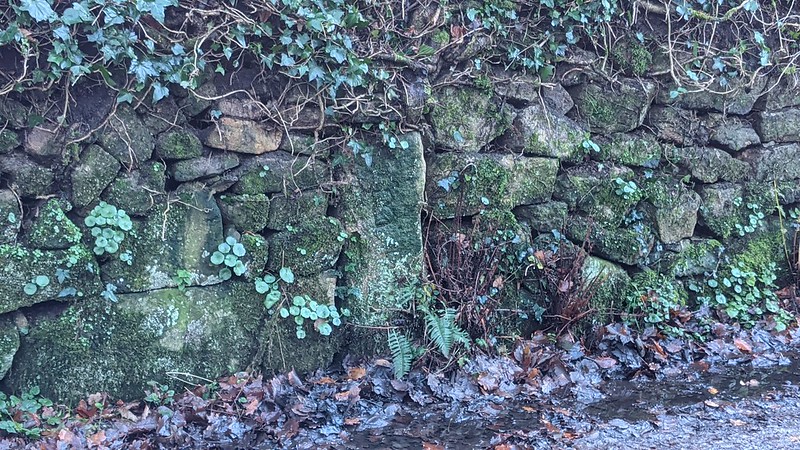
The map suggests that the stone has been moved from the entrance as it is embedded in the wall of a later property opposite at SX 6561 9219 but the minor relocation is unconfirmed. Aside from its lowly stature, this stone differs from the others as it only has a ‘B’ inscribed.
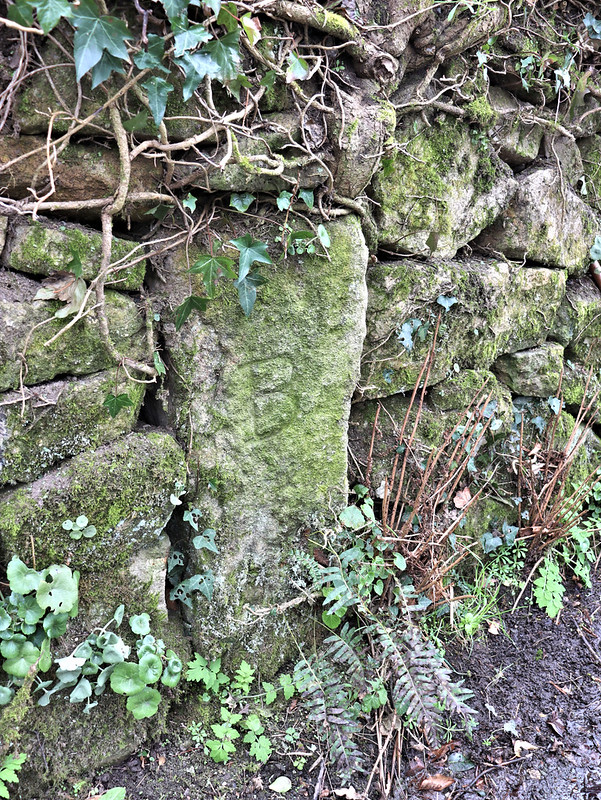

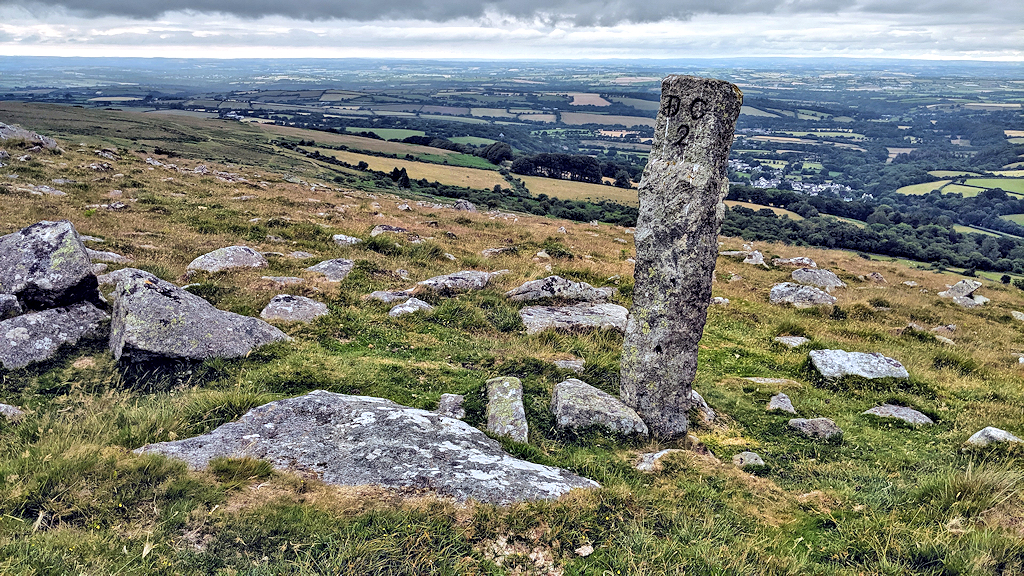
4 replies on “The South Zeal / Duchy of Cornwall Stones”
Brilliant blog post, Paul: an interesting read with great research done in an area I've not really explored as much as I would've liked. It would be great to see SZ 4 stood upright one day.Cheers,Max
Thanks Max,It's a subject that has me hooked. Rest assured SZ4 will be upright some time early next year.CheersPaul
Really great look forward to stone being put again.Paul
[…] at South Zeal. Paul Buck has also written an in depth blog on the subject which can be found here: https://www.torsofdartmoor.co.uk/blog/2021/09/01/dartmoor-the-south-zeal-duchy-of-cornwall-stones/ Skaigh House from across the River Taw valley near Skaigh (or Belstone Rabbit Warren). Skaigh […]